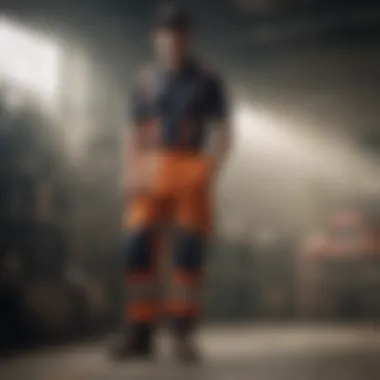Breathable Work Pants for Hot Weather in Australia


Intro
Choosing suitable workwear in hot climates, especially in Australia, can significantly impact comfort and performance. Breathable work pants have become essential for professionals facing elevated temperatures. Unlike regular pants, these specialized garments offer ventilation, moisture-wicking properties, and lightweight materials. Understanding their features helps consumers make informed choices supporting their workplace needs.
The Importance of Breathable Fabrics
Breathable fabrics play a crucial role in maintaining comfort during hot weather. They ensure air circulation and wick away sweat, reducing discomfort. Many brands used materials like cotton blends, bamboo, and synthetic fabrics designed with micro-pockets that enhance airflow. When selecting pants for hot weather, it’s vital to consider fabric choices.
Essential Design Features
The design of breathable work pants varies widely, with specific characteristics aimed at enhancing functionality. Key elements include:
- Lightweight fabric: Ensures comfort and reduces the strain on the body during warm days.
- Moisture-wicking technology: Draws sweat away from the skin, keeping the wearer dry.
- Loose fit: Allows airflow, preventing the feeling of restriction while working.
- UV protection: Provides an added layer of defense against harsh sunlight.
Investing in pants with these attributes ensures long-lasting comfort and protection during work hours.
Fashion Trends
In the world of breathable work pants, trends continually evolve. Comfort doesn’t have to mean sacrificing style, and many workers look for solutions that blend both.
Seasonal Styles
For warmer months, colors like lighter shades become popular. Neutral tones are favored for their versatility in pairing with various tops. Additionally, patterned fabrics can add unique style, giving wearers a chance to express individuality.
Influencer Inspirations
Social media influencers increasingly showcase breathable work pants as part of their daily ensembles. They highlight practical styles that not only serve workplace requirements but also cater to casual events. Following these fashion leaders helps individuals discover new ways to wear and combine their work attire.
"Breathable fabrics allow for more versatility during hot weather, making them ideal for both work and leisure." - Fashion Expert
End
Breathable work pants are essential in Australia's hot climate. Their specialized fabric and thoughtful design make them a requirement for comfort. As fashion trends shift, embracing practicality and style becomes vital. Choosing the right pair can enhance workplace productivity and enable individuals to maintain a fashionable presence, no matter the occasion.
Preamble to Breathable Work Pants
Finding the right work pants for hot weather is crucial, especially in a country like Australia with its varied climate conditions. Breathable work pants serve as a solution to comfort and practicality, allowing individuals to stay cool during prolonged exposure to high temperatures. It is essential to understand the characteristics of breathable work pants to make informed choices.
Hot weather comes with unique challenges. When wearing work pants, one must consider not only protection but also comfort levels. Breathable pants are designed with fabrics that allows air circulation and moisture escape, which is vital for maintaining a comfortable body temperature. The right choice can directly impact performance and overall well-being.
In this article, the discussion will reveal the importance of various fabric types, their specific designs, and how they cater to Australian weather. Consumers must look for functionality as well as durability while selecting breathable work pants. Additionally, the focus will be on several brands that offer these products and highlight user preferences in the choices they make. Increasing awareness of the significance of breathable workwear also drives consumer demand, making this topic highly relevant.
Being informed about the available options will empower the reader to make wise decisions. Ultimately, good breathable work pants not only enhance comfort but also improve productivity levels, which is why understanding their qualities is crucial.
Importance of Breathability in Workwear
Breathability in workwear, particularly in garments like pants, plays a crucial role in overall comfort and functionality, especially in hot climates like that of Australia. When temperatures rise, the body tends to sweat more to regulate its heat. This increased perspiration can lead to significant discomfort if the fabric does not allow for adequate airflow and moisture evaporation. A breathable fabric helps maintain a microclimate next to the skin, enabling air circulation and the movement of moisture away from the body.
Understanding Breathable Fabrics
Breathable fabrics are designed to facilitate airflow while allowing moisture to escape. The processes involved in the creation of such materials often include weaving techniques and fabric treatments that enhance their properties. Common examples include cotton and various synthetic blends. Cotton allows for natural ventilation and comfort due to its inherent qualities. In contrast, synthetic materials like polyester are often engineered to provide moisture-wicking capabilities, effectively pulling sweat away from the skin.
Choosing the right fabric is essential for specific tasks and activities. For example, those working in construction or outdoor jobs may prefer heavier-duty fabrics that balance durability and breathability. On the other hand, roles requiring mobility might favor lighter, more flexible options.
Impact on Comfort and Productivity
With workwear that promotes breathability, comfort significantly improves. In a sweltering environment, workers can experience fatigue and irritability when overheated. Such discomfort can detrimentally affect concentration and productivity levels. Additionally, breathable work pants allow for unimpeded movement, which is vital in many occupational settings.


A survey of employees in various fields revealed that those in breathable workwear reported higher satisfaction rates in terms of comfort and performance. A notable takeaway is that when workers feel comfortable, they tend to be more engaged and productive. Investing in suitable breathable work pants is not merely a matter of style but rather a strategic decision that impacts efficiency and well-being.
"The right workwear can mean the difference between a good day at work and one that feels unbearable."
Key Fabric Types for Hot Weather
Selecting the right fabric type is essential when searching for breathable work pants, especially in the context of Australia's hot climate. The material chosen impacts comfort, durability, and performance, making it important to understand the options available. Many factors come into play, including moisture management, breathability, and weight of the fabric. This section outlines three key types of fabrics commonly used in breathable work pants to help guide informed decisions.
Cotton and its Advantages
Cotton is a natural fiber known for its softness and breathability. It is a widely appreciated fabric in hot weather as it allows air circulation while absorbing moisture. In terms of work pants, cotton provides several benefits:
- Comfortable Feel: The softness of cotton results in a comfortable wear which is crucial during long working hours.
- Natural Moisture Absorption: When engaging in physical activity, cotton can wick moisture away from the skin, helping to maintain dryness and comfort.
- Hypoallergenic Properties: Cotton can be suitable for people with sensitive skin since it generally produces fewer irritations.
However, it is a good idea to note that cotton can take a while to dry compared to synthetic fibers. Overall, its comfort makes it an appealing choice for workplace attire, as long as one considers the moisture retention factor.
Synthetic Materials Overview
Synthetic materials like polyester and nylon play an important role in creating breathable work pants. These fabrics offer significant advantages over traditional cotton fabrics. Some notable features include:
- Quick Drying: Synthetic fibers can dry rapidly, making them ideal for hot, sweaty conditions. This characteristic allows workers to stay comfortable even in extreme heat.
- Durability: Synthetics are often more resilient and resistant to wear and tear. This means that pants made from these materials may last longer than those made from cotton.
- Lightweight composition: Many synthetic fabrics can be lightweight, reducing the burden on the wearer, particularly during hot weather.
On the downside, synthetic materials can sometimes feel less breathable than natural options and may trap heat and moisture if not designed effectively.
Blends for Optimal Performance
Blended fabrics combine the advantages of both natural and synthetic fibers, creating a versatile solution for hot weather work pants. Common blends include cotton-polyester and cotton-nylon blends. The benefits of using blended fabrics include:
- Improved Breathability and Comfort: Blends can offer the softness of cotton while maintaining the durability and moisture-wicking capabilities of synthetics.
- Enhanced Performance: By combining different fibers, manufacturers can optimize the pants for specific functionalities—balancing comfort and durability more effectively than single fabrics.
- Versatility: Blended fabrics often adapt well to various working conditions, making them suitable for different types of jobs and environmental factors.
"Selecting the right fabric not only influences comfort but can also impact productivity in hot environments."
By weighing these options carefully, individuals can find the best fit for their work needs in Australia's warm weather.
Design Features of Breathable Work Pants
In hot climates like Australia, work pants need to go beyond basic functionality. The design features of breathable work pants are essential as they greatly influence comfort and performance. These features enhance airflow, manage moisture, and provide appropriate fit, responding to the unique demands of elevated temperatures during work hours.
Ventilation Mechanisms
One of the primary design features in breathable work pants is the incorporation of ventilation mechanisms. These can include mesh panels, air vents, or strategic cutouts that facilitate airflow. By enhancing ventilation, these pants help to regulate body temperature and reduce sweating. This is especially important for outdoor workers who are exposed to the sun for long periods. Workers can experience increased focus and diminished discomfort when adequate ventilation is present.
Moisture-Wicking Properties
Moisture-wicking technology is another critical feature of breathable work pants. Fabrics designed with this technology pull perspiration away from the skin, allowing it to evaporate more quickly. This not only keeps the wearer dry but also helps to prevent chafing and irritation, which can occur from prolonged moisture contact. Choosing pants that have moisture-wicking properties is key for staying productive in the heat. Many popular fabric blends used in work pants offer this benefit, making it essential for consumers to assess these features when purchasing.
Cut and Fit Considerations
The cut and fit of breathable work pants should not be underestimated. A well-fitted pair of pants will allow for natural movement while providing comfort during physical tasks. Styles that offer a looser fit can enhance airflow, but they must not compromise on the ability to work effectively. Additionally, consider pants with features like adjustable waistbands or articulated knees for tailored fit and flexibility. The right cut can enhance both comfort and function, leading to improved overall satisfaction in work environments.
"Choosing the right design features in work wear can significantly affect efficiency and comfort during hot weather."
In summary, the design features of breathable work pants play a pivotal role in ensuring comfort and performance for workers in hot climates. Focusing on ventilation mechanisms, moisture-wicking properties, and appropriate cut and fit can help individuals select pants that best suit their needs.
Climate Considerations in Australia
Regional Variability in Temperatures
Australia displays significant regional differences in temperatures. In places like Darwin, you can expect warm, humid conditions year-round, while cities such as Melbourne and Hobart experience cooler winters. The northern regions often see temperatures exceed 30 degrees Celsius, particularly in the summer months.


This variability means that the selection of breathable fabrics should take into account not just the general climate but local conditions where one lives and works. Workers facing extremely high temperatures need pants designed with lighter materials and better ventilation.
- Northerly regions: Focus on fabrics that are lightweight and quick-drying.
- Southern areas: Breathable pants should also provide some level of insulation during cooler periods.
Understanding these nuances can help prevent discomfort and overheating, thus improving productivity and overall well-being while working.
Humidity Levels and Their Impact
Humidity plays a significant role in how breathable work pants perform. In coastal areas or regions with tropical climates, high humidity can make temperatures feel much warmer. This discomfort can lead to fatigue and decreased efficiency during work hours. Thus, moisture-wicking technologies in fabrics become essential.
- Impact of humidity on comfort: Fabrics that trap moisture can intensify the feeling of heat, making the wearer uncomfortable.
- Importance of fabric selection: Pants made from materials that allow for ventilation and moisture escape help maintain a comfortable microclimate next to the skin.
"Proper fabrics decrease heat stress and enhance overall comfort in high-humidity areas."
By recognizing how regional humidity affects thermal perception, one can make informed decisions in selecting breathable work wear. This understanding supports the goal of staying cool, comfortable, and productive throughout the workday.
Popular Brands Offering Breathable Work Pants
When considering the option of breathable work pants, it is essential to focus on the brands that specialize in creating solutions for hot climates. The right brand can mean a notable difference in comfort and functionality. With various manufacturers on the market, understanding specific features, strengths, and innovations offered by these brands becomes crucial for making an informed choice.
Overview of Key Players
Several brands dominate the landscape of breathable workwear in Australia. Each brand brings its unique approach to design and fabric technologies, catering to the specific needs of those working in elevated temperatures. Brands such as Carhartt, DICKIES, and Caterpillar are known for their reliability and performance under hot conditions.
- Carhartt: This brand stands out due to its commitment to durability. Their work pants often combine breathable materials with ruggedness, appealing to labor-intensive roles.
- DICKIES: Known for various styles and cuts, DICKIES provides choices that balance comfort with professionalism. Their focus on functional design means employees can move easily throughout their tasks.
- Caterpillar: Offers innovation in breathable fabrics, often integrating moisture-wicking technologies. Their work pants are engineered for high-performance scenarios.
This is just a sample of the brands available. Each provides different advantages, depending on workplace settings and job demands.
Brand-Specific Innovations
Innovation plays a substantial role in the development of breathable work pants. Brands frequently refine their products to respond to consumer feedback and environmental conditions.
- Carhartt has recently introduced FastDry technology, which enhances moisture management, keeping wearers dry even during intense heat.
- DICKIES focuses on Flex Fabric, allowing for stretch and ease of movement. This characteristic helps accommodate a wide range of activities without feeling restricted.
- Caterpillar has implemented a Nano-Technology finish on select items. This makes the fabric highly resistant to liquid and helps to repel stains, which is beneficial in work settings.
Understanding these innovations can guide consumers in selecting the right work pants for their specific needs.
To sum it up, focusing on brands specializing in breathable work pants provides various solutions for maintaining comfort while performing in high temperatures. By examining features and innovations, individuals can choose wisely in terms of both function and comfort.
Consumer Preferences and Trends
Understanding consumer preferences around breathable work pants is vital for several reasons. First, consumers are not just looking for functionality; they also desire comfort, style, and practicality. This has led to a rise in demand for work clothing that can handle high temperatures without sacrificing style. The right pants can significantly affect how employees feel during long working hours, especially under the hot Australian sun.
Furthermore, trends in purchasing behavior have shifted. People are increasingly turning toward brands that prioritize eco-friendliness and sustainability in their manufacturing processes. Awareness of climate issues affects choices more than before, leading users to select products that align with their values. Hence, businesses need to keep abreast of these evolving trends in order to meet the expectations of their customer base.
Surveying User Experience
Conducting surveys on user experiences provides valuable insights into how breathable work pants perform in real-world conditions. Responses often encompass a range of factors from comfort levels to durability. Most users highlight the significance of moisture management, as effective perspiration control can translate to practicality in warm environments.
Additionally, feedback often addresses the fit and cut of the pants. A desirable feature is a relaxed fit, allowing for unrestricted movement throughout the day.
Some users suggest specific areas where brands can improve. Issues like seam strength and fabric pilling frequently come up. When brands are receptive to these critiques and adjust their offerings accordingly, it builds trust and loyalty among consumers. Incorporating user feedback helps companies innovate while simultaneously enhancing user satisfaction.
Sustainability Considerations
The modern consumer is more informed and conscientious about their purchasing practices. Sustainability is at the forefront of their decision-making process. Breathable work pants made from organic cotton or recycled polyester are gaining traction. Each responsible choice contributes to less environmental damage, and consumers feel good about their purchases.
Brands that employ eco-friendly processes can attract environmentally aware customers. Many shoppers prefer fabrics that have low-impact manufacturing processes. Recognizing this trend is essential for brands looking to capture market share.


Moreover, designers are actively exploring renewable materials and responsible production methods. Consumers often appreciate transparency in these practices. When brands communicate their sustainability efforts through clear labeling and marketing strategies, it boosts credibility.
Additionally, the longevity of the product also plays into sustainability. High-quality, durable materials are more appealing, reducing the amount of waste produced. Users tend to favor items that last longer, reflecting not only economic prudence but also environmental consideration.
In summary, aligning product offerings with consumer preferences and sustainable practices is crucial for success in today’s market. Brands must stay updated on user insights and evolve with their needs.
Care and Maintenance of Work Pants
Maintaining breathable work pants is crucial for ensuring comfort and functionality, particularly in hot weather conditions. Proper care can extend the life of the fabric while preserving its breathable qualities. Given that these pants are often subject to sweat, dirt, and wear from daily use, there are several essential practices workers should adopt to maintain their performance.
Washing Guidelines
When it comes to washing breathable work pants, adherence to specific guidelines can make a significant difference. Always check the care label provided by the manufacturer for customized instructions, as different materials may have different requirements.
- Wash in Cold Water: This helps to preserve the colors and prevents shrinking.
- Use Gentle Detergents: Avoid bleach and fabric softeners as they can damage breathable fabrics and reduce their effectiveness.
- Avoid Overloading the Washing Machine: This ensures that water can circulate freely, allowing for better cleaning.
- Air Dry Whenever Possible: High heat from dryers can affect the integrity of materials. Letting pants air dry helps maintain breathability.
Proper washing practices can significantly increase the lifespan of work pants, making them a wise investment in comfort and functionality.
Longevity Factors
Several factors influence the longevity of breathable work pants. Understanding these will help consumers make informed decisions and care for their garments effectively.
- Fabric Quality: Higher quality fabrics tend to resist wear and tear better than lower-quality alternatives. Investing in reputable brands often pays off in durability.
- Frequency of Use: Regular use can lead to faster deterioration. Rotating between multiple pairs can extend the lifespan of each piece.
- Storage Conditions: Keeping work pants in a cool, dry place reduces the risk of mold and fabric degradation. Avoid hanging them in direct sunlight.
- Repairing Instead of Replacing: Small tears or damages can often be mended. This not only prolongs the life of the pants but is also more sustainable.
In summary, when attention is given to the care and maintenance of breathable work pants, it results in better performance and increased durability. Understanding washing practices and longevity factors can empower consumers to make smarter choices for their workwear.
Potential Drawbacks of Breathable Fabrics
While breathable fabrics offer numerous advantages for hot weather work pants, it is essential to address the potential drawbacks associated with them. For some, these downsides might outweigh the benefits. Understanding these drawbacks can help consumers make informed decisions when selecting workwear that balances comfort with longevity and cost-effectiveness.
Durability Concerns
One significant drawback of breathable fabrics is their durability. Many breathable materials are lighter and thinner than traditional work pants, which can enhance airflow but might sacrifice strength. Fabrics like lightweight cotton or polyester blends may wear out more quickly, especially in demanding work environments. This raises concerns about
- Pilling: As these fabrics tend to be softer, they might pill with repeated wear and washing.
- Tearing: Lightweight materials might tear more easily upon snagging or during rugged activities.
- Fading: Color retention can also be problematic, especially under constant exposure to sunlight.
These durability issues can lead to more frequent replacements, which ultimately may not be economically viable for frequent users. It's crucial to evaluate the environment in which the work pants will be used. For those working in labor-intensive settings, investing in reinforced or heavier-weight breathable options can help accommodate both comfort and durability.
Cost Considerations
In addition to durability, the price of breathable fabrics can be a concern. While there is a range of pricing in the marketplace, high-quality breathable work pants often come with a premium price tag. Specialized fabrics designed for maximum breathability and comfort frequently utilize advanced technology, which can drive costs up. The following points are worth considering:
- Price vs. Quality: While cheaper options might seem appealing, they may lack the essential features needed for breathability, compromising comfort and long-term value.
- Value in Longevity: Investing more in durable breathable work pants can ultimately be more economical. Pants that last longer reduce the frequency of replacements.
- Budget Constraints: Consumers might be limited by budget, influencing the choice between less expensive, lower-quality options or more costly, higher-quality breathable pants.
Ultimately, understanding the potential drawbacks of breathable fabrics allows consumers to weigh their options carefully. By considering factors like durability and cost, one can make more informed choices that align with individual needs and work demands. This aligns with the overarching objective of seeking comfort without compromising on quality.
Ending
The concluding section of this article underscores the significance of breathable work pants, particularly in the context of Australia’s warm climates. In this guide, we have explored various facets of breathable workwear, from the materials that facilitate comfort to the specific design features that optimize airflow and moisture control. These pants are not solely a matter of comfort; they have a pivotal role in enhancing workplace productivity and overall well-being during the sweltering months.
Key Elements to Consider
- Fabric Choices: The choice of fabric is paramount. Understanding breathable fabrics such as cotton, synthetic materials, and blends can greatly impact the wearer’s experience. Each fabric holds unique properties that contribute to ventilation and moisture management.
- Design Features: Features like ventilation mechanisms, moisture-wicking properties, and a flattering fit align practicality with style. Workers must consider these aspects to maintain comfort throughout their workday.
- Climate Awareness: Recognizing the environmental conditions unique to different regions of Australia aids in selecting the appropriate attire. The distinct temperature variations and humidity levels present specific challenges that can be addressed with the right work pants.
Benefits of Breathable Work Pants
Breathable work pants contribute to better physical comfort, which in turn can improve concentration and efficiency on tasks. As noted throughout the article, comfort is not a luxury; it is a necessity in certain professions, particularly those requiring outdoor labor.
Moreover, as sustainability becomes a more pressing concern, selecting breathable options that use eco-friendly materials supports both personal and environmental health.
Final Considerations
As we conclude, it is clear that breathable work pants are an essential investment for anyone working in hot weather. Balance between comfort, durability, and style should guide your choice. Additionally, being well-informed about maintenance and care can enhance the longevity of these garments.
Ultimately, selecting breathable work pants is about prioritizing personal well-being while ensuring that professional responsibilities are met efficiently and effectively. By taking these factors into account, one can achieve a significant upgrade to their work attire, fostering a more productive and comfortable experience in the heat.



